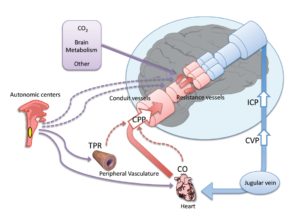Cerebral Autoregulation

Blood-brain barrier separates the vessels of the CNS from that of the cardiovascular system, therefore, these blood vessels are regulated by an intrinsic mechanism called Cerebral autoregulation.
Cerebral regulation involves the natural processes of the body. These natural processes thus controls the cerebral blood flow within the normal range, during the change in blood pressure. These physiological mechanisms control even the small arteries once activated.
Mechanisms of cerebral autoregulation
Mechanism of cerebral autoregulation is a well-regulated process.
Therefore, we have three different theories about the mechanisms of cerebral autoregulation.
- Myogenic theory
- Metabolic theory
- Neurogenic theory
WATCH WORLD’S BEST VIDEO LECTURE ON THIS TOPIC (SIGNUP REQUIRED)
Myogenic Theory
This theory states that contraction or relaxation of smooth muscles around the walls of arteries regulates the changes in the blood pressure. Thus contraction and relaxation at an appropriate time can restore the blood pressure to the normal.
Metabolic Theory
This theory states that a metabolic substance regulates the changes in the blood pressure and thus controls the changes in the blood pressure.
Neurogenic Theory
This theory states that the brainstem regulates the changes in the blood pressure because the brainstem has corresponding brainstem centers.
Example, Nitric oxide.
WATCH WORLD’S BEST VIDEO LECTURE ON THIS TOPIC (SIGNUP REQUIRED)
Disclaimer: The information provided on this website (www.MadeForMedical.com) is only for educational purpose. While we tried hard to write quality articles but still, the articles and the information within them is not guaranteed to be free of factual errors or typos and hence may not be correct. You are advised to independently verify the claims in the articles and make your own conclusion.
